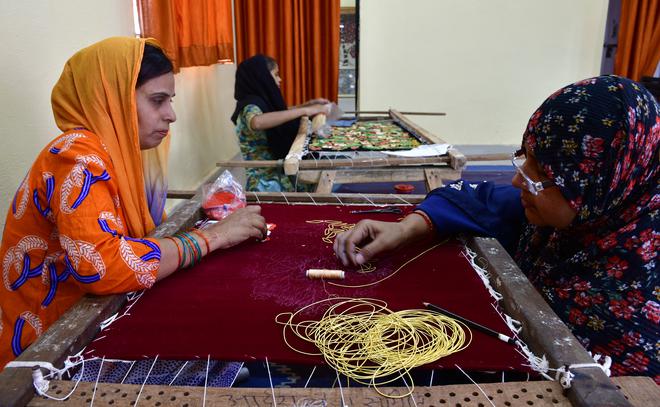As the United Kingdom (U.K.) was getting ready for its new king, a quiet neighbourhood near the Taj Mahal in Agra was busy burning the midnight oil. They were quickly churning out two lakh car hangers designed like the crown that was to be worn by King Charles III at his coronation.
Made with the intricate zardozi embroidery technique that uses thin metal threads on silk, satin, or velvet, the car hangers needed to reach the U.K. within a month, as memorabilia to mark the event there.
Returns from the labour-intensive cottage industry — that has been around since the 12th century — had been diminishing. With the artisans’ livelihood under threat, the Agra Smart City Mission undertook an exercise from 2019 to reorient products to suit the export market, inbound and domestic tourist retail, and niche corporate gifting needs. They set up four micro skill development centres across the city for this.

Besides zardozi, marble inlay and carpet making were the other crafts identified. Week-long, full-day training sessions have been carried out for about 300 artisans from self-help groups (SHGs).
According to Alok Saxena, project manager of the micro skill development initiative, a market survey conducted before beginning the programme showed that tourists, both foreign and domestic, preferred to buy pocket-friendly souvenirs compact enough to carry back home. “We decided to reskill these artisans to give them design ideas on what to make,” he said.
Marble inlay work for example, focused on embellishments instead of larger designs. Similarly, in the carpet industry, the design for the famous Agra dari woven in a colour-blocking technique, was redesigned to make wall hangings with intricate embroidery. Everything was reoriented to be done by hand to bring down pollution around the Taj Mahal.
“We trained them in retaining the essence of the craft while working on the pattern,” said designer Swati Gupta, a trainer for marble inlay work.
Theme-based training was also given. Results included zardozi rakhis during Rakshabandhan, Braj- and Madhubani-themed wall hangings during Janmashtami, and a special series of car hangers and coasters for Christmas.
“The focus was on popular themes. One of the first ranges to be created was on yoga, to attract the overseas market,” said Ms. Gupta.
There is also another set of training workshops for digital and financial literacy and entrepreneurship that includes insights on how to market products on e-commerce websites like Amazon and Flipkart. The digital literacy training was given through an initiative involving Dell.

The entire operation is carried out with 107 SHGs — each with 10-15 members — out of which 100 have only women members. All the SHGs have their own bank accounts with money being credited there directly. To date, 1,230 women have been given entrepreneurship training. Annually, at least four training sessions are carried out for consistent skill upgradation.
These SHGs are managed by five federations, which in turn come under the umbrella of a city-level federation responsible for marketing and order creation. The turnover of the city federation has been ₹30 lakh between July 2021 to March 2023.
The workshops have almost tripled their household incomes, say the artisans. Danish Baksh’s family has been traditionally involved in marble inlay work. Despite a post-graduate degree in history Mr. Baksh had difficulty finding employment, and was only able to find jobs in small factories doing the same work as his forefathers, barely making ₹8,000 a month. This too stopped during the COVID-19 pandemic, making it difficult for his family to survive.
After the reskilling, he set up an SHG with 10 members and is manufacturing products like wall plates and other décor items. “Our family’s income has jumped to ₹25,000 a month,” he said.







